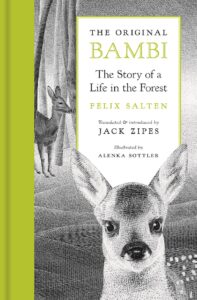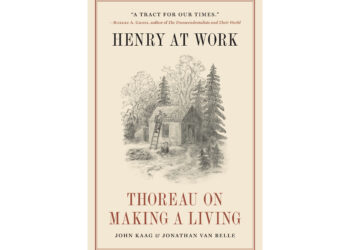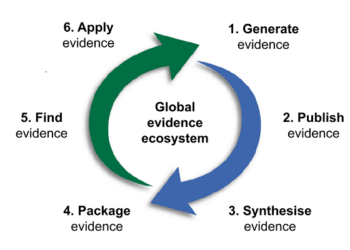NOTE: We’re mid-way through summer and still people are looking for good books to take on vacation. Academics are still hopeful that they’ll catch up on some serious reading in their field and students are procrastinating over any assigned reading. Whether or not you fall into any of those categories, today’s Scholarly Kitchen post is part of a short series of book reviews of humanities titles emerging from independent and university presses. Each one represents a great read.
If you read Bambi growing up, most likely it was in one of the bowdlerized versions associated with Walt Disney’s 1942 animated film. The film rights to Bambi — written by a relatively unknown Austrian journalist — were handed off to the Disney studios in 1933 and a book originally intended for adults was twisted and transformed into a movie aimed at an audience of children. It is this type of back-story that can sometimes make a literary property difficult to keep alive in a modern market. A loving parent or grandparent might buy Jack Zipes’ 2022 translation, thinking fondly of an on-screen Thumper (the rabbit) and Flower (the skunk), but then become outraged when they realize that the substance of The Original Bambi: The Story of a Life in the Forest is really quite a different text.
 This is where a scholarly or university press can have a real advantage over trade publishers in successfully reviving an older work for a modern readership. Princeton University Press is able to attract a serious scholar such as Jack Zipes in order to produce the necessary high-quality translation and an appropriate introduction to place the work in context. The press can also bring in the contributions of an award-winning illustrator to contribute new artwork appealing to both adult as well as young-adult readers without any reference to previous impressions. The final output attracted the attention of reviewers from a variety of publications, but only caught my attention when I saw the artwork featured in the AUPresses 2023 Book, Jacket, and Journal Show.
This is where a scholarly or university press can have a real advantage over trade publishers in successfully reviving an older work for a modern readership. Princeton University Press is able to attract a serious scholar such as Jack Zipes in order to produce the necessary high-quality translation and an appropriate introduction to place the work in context. The press can also bring in the contributions of an award-winning illustrator to contribute new artwork appealing to both adult as well as young-adult readers without any reference to previous impressions. The final output attracted the attention of reviewers from a variety of publications, but only caught my attention when I saw the artwork featured in the AUPresses 2023 Book, Jacket, and Journal Show.
From a personal standpoint, I bought the book on the basis of Alenka Sottler’s striking artwork as I had no particular interest in reading Bambi at that point. The physical book itself is nicely produced. What I hadn’t expected was how well the artwork would translate to an imperfect e-ink environment, whether that of a Paperwhite device (several generations old) or that of the 2022 Kindle Scribe device. Even on a cheap Android tablet, the dozen or so black-and-white illustrations display well, drawing in the reader.
Slowly turning the pages of the physical copy, my eye would drift over to the facing page of text and this is when I began to actively engage with Felix Salten’s work.
Zipes views Salten’s novel as a political commentary for adult readers, an allegory that relates the experiences of various minorites living in Vienna between the two World Wars. His message is that living creatures – prey or predator – ultimately live (and die) alone. All creatures are in conflict in the effort to survive. (One who we see die alone in the forest is a human, shot by the hunter whose game he is poaching.) There is minimal room for trust between living creatures; one of the other deer comes to trust the humans too much, assuming he has no need to fear those who fed him by hand when, as a fawn, he was their pet. In one of the final chapters, a brutal scene underscores the gap in trust when domesticated animals are shown in conflict with those in the wild. Cornered by hounds, a wounded fox turns and calls his foe a thug for tracking hidden prey in spaces where the unnamed Hunter would never otherwise find him. The hound ultimately rips out the throat of the fox.
There are some story elements that Disney retained – Bambi encountering a butterfly for the first time – but Salten’s book is not saccharine. The dialogue of the animals has been anthropomorphized, but there is a far greater dignity to them. It’s not Thumper you meet here. It’s Hare. (There is no skunk named Flower. Skunks, after all, are not indigenous to Europe.) Instead the running theme of the book, arising from conversations with the Old Stag is whether Bambi has recognized a primary truth – that all living creatures ultimately live and die on their own. Even the living being who possesses a technical advantage (that is, the unknown “He” in possession of a hunting rifle) faces death alone. This is not the Bambi most adults recognize.
As it happens, there was competition for modern sales. In 2022, The New York Review of Books (NYRB) brought out its own edition of Bambi. Their approaches to formatting and marketing were decidedly different. The slim NYRB paperback has minimal cover design, no internal frontispiece or other illustrations, not even specific chapter numbering. The buyer might or might not know the work of experienced editor and translator, Damion Searls.
Marketers at both presses had to battle against a host of deeply entrenched preconceptions of the content. Efforts (I assume) would have been focused on ensuring that positive notice appeared in such diverse publications as The New Yorker, Forbes, and the Times Literary Supplement. The vaguely-defined “serious reader” tends to lurk in odd corners and it isn’t always evident when you’ve reached them. None of this effort would have been easy and I commend every single marketing staff member involved.
To say I “enjoyed” reading Bambi wouldn’t be entirely true. It is, as the reviewer in The New Yorker noted, a rather bleak text. Reading it as an adult, it kept my attention; when I shared my recommendation with others on the LibraryThing platform, several came back to me and told me they’d forgotten (if they’d ever known) just how harsh the reading experience was.
Operating in the trade publishing sector is something that perhaps only the largest and well-resourced university presses may be able to do. The Original Bambi may or may not qualify as a twentieth-century classic, but the book has benefited from the care shown here by the collaborative team of translator, artist, editor, and press staff. This particular edition is a high-quality example of the value added to a text via an attentive publishing process.
Discussion
5 Thoughts on "Bambi for the Serious Reader"
Great essay; thanks, Jill.
Bambi isn’t alone … around 19 years ago, Alison Lurie wrote a wonderful NYRB appreciation of the original 1880s Italian novel *The Adventures of Pinocchio* — also, interestingly, by a journalist (Carlo Collodi).
“Today, many people have the illusion that they know who Pinocchio is,” Lurie wrote. “They know Pinocchio only from the sentimentalized and simplified Disney cartoon … The original novel by Carlo Collodi, which today survives mainly in scholarly editions, is much longer, far more complex and interesting, and also much darker.”
https://www.nybooks.com/articles/2004/06/24/the-good-bad-boy/
Thanks, Stewart! I had considered re-reading Pinocchio as well in recent months. Much of my reading in 2023 has related to the idea of what constitutes classic literature and as a follow-up, what is the impact of a film adaptation in lending credibility to a specific title. As an example, Louis Bromfield was a Pulitzer Prize winning author, although not many people will have heard of Early Autumn which earned him that honour. However, another book of his, The Rains Came, had two movie adaptations. (Hollywood saw it as a great romance. The first adaptation had Tyrone Power and Myrna Loy in the leading roles; the second adaptation starred Richard Burton and Lana Turner. ) But if you actually read the hefty novel published back in 1937, you discover that the romance was peripheral to the point of the book. That novel’s point had far more to do with allowing the country of India (still then under British control) to become autonomous. Hollywood movie buffs may be familiar with the two films but they won’t have understood the intention of the author. Movie adaptations can wreak havoc with our long-term understanding of literature!
Thanks for a thoughtful review. Everyone involved in this book did take quite a lot of care in the production of the print and the ebook editions. Our printer used stochastic printing methods to capture the detail in the art. I especially appreciate your comments on the ebook as reviewers rarely comment on this.
I had a similar experience recently when I attended a ballet version of The Little Mermaid. It was based upon the original fairy tale, not the Disney version.
There were many empty seats after intermission.
In case that you speak German: There was an excellent feature on Bavarian television in March 2023 called “100 Jahre Bambi” (100 years of Bambi; duration six minutes). Translation of the intro text: “Everyone knows Bambi – they think … But very few people know the story of the roe deer, which Walt Disney later turned into kitsch. Exactly one hundred years ago, the hunter Felix Salten published “Bambi: A Life in the Woods,” which is definitely not a children’s book. It is about existential themes, about living and dying, violence, animal welfare, antisemitism and the impoverishment of our nature.”
Link to the video:
https://www.br.de/br-fernsehen/sendungen/capriccio/kulturmagazin-capriccio-100-jahre-bambi-100.html



